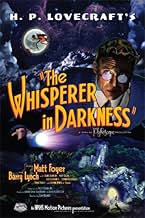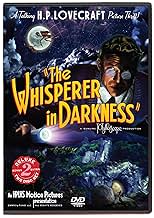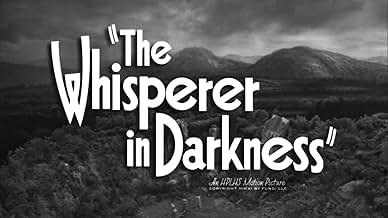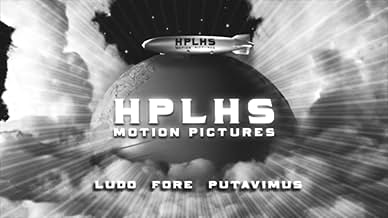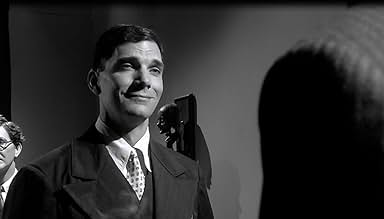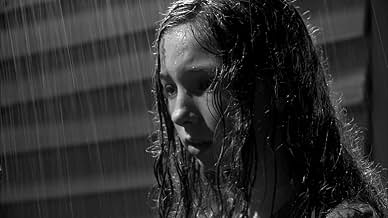AVALIAÇÃO DA IMDb
6,5/10
3,8 mil
SUA AVALIAÇÃO
Adicionar um enredo no seu idiomaBased on the H. P. Lovecraft story of the same name, a folklorist investigates reports of unusual creatures in Vermont only to uncover more than he bargained forBased on the H. P. Lovecraft story of the same name, a folklorist investigates reports of unusual creatures in Vermont only to uncover more than he bargained forBased on the H. P. Lovecraft story of the same name, a folklorist investigates reports of unusual creatures in Vermont only to uncover more than he bargained for
- Direção
- Roteiristas
- Artistas
- Prêmios
- 3 indicações no total
Conor Timmis
- Porter
- (cenas deletadas)
- Direção
- Roteiristas
- Elenco e equipe completos
- Produção, bilheteria e muito mais no IMDbPro
Avaliações em destaque
I saw almost everything whats's been done in term of so called "Lovecraft Cinema". From '63 The Haunted Palace , through '85 Re-Animator and 2005 Call Of Cthulhu. This is by far one of the best Lovcraftian adaptations. It really holds the right spirit of both his books and early 50-ties sci-fi cinema. If you're looking for speedy CGI action - forget about this one. If you're into Edgar Allan Poe books, '31 Frankenstein or '56 Forbidden Planet and know at least who Lovecraft is you should definitely see this. Decent acting, good script filmed with the right pace and an old-school production. A perfect alternative for these days cinema. Highly recommended!
The Whisperer in Darkness ranked in the "pretty good" range of Lovecraft adaptations, for me. The higher range would include Re-Animator, From Beyond, and A Color Out of Space, while the lower range would include Beyond the Wall of Sleep and The Deep Ones. The mid-range is populated by such movies as The Unnamable, Dagon, and Necronomicon, and is a fuller list than either of the other ranges of the spectrum. In The Whisperer in Darkness, we are plagued by poor acting by the little girl, and questionable acting by the lead and main antagonist. The special effects range from mid- to questionable, as well. But as an indie movie, it does really well, and way better than I had expected. I highly recommend to Lovecraft fans, as this one definitely held my attention, and I understand people consider it a pretty faithful adaptation.
One cannot help but give full marks to the H.P. Lovecraft Historical Society for their efforts to bring H. P. Lovecraft's eerie stories to the screen in a manner in keeping with the texture and mood of the original material. Although there have been other attempts to film Lovecraft stories, most have generally been unsatisfying failures due to misguided attempts to modernize or glamorize them. Not so with HPLHS, who have gone out their way to keep faithful to the period and locales in which the tales were set, even going so far as give the film the feel of an early-1930s black-and-white movie. Even their logo is an homage to the the old Universal Studios logo of the early 1930s (the studio which produced such classic horror movies as Frankenstein, Dracula and The Mummy), replacing the familiar airplane-circling-the-earth with a dirigible.
The plot involves Albert Wilmarth, a college anthropology professor specializing in folklore, who becomes intrigued by a series of unusual newspaper stories reported from a rural part of Vermont after a period of particularly heavy rains. It seems that bodies have been observed washing down from the mountains in the swollen rivers, bodies which are, reportedly, neither human nor animal. The bodies apparently also recall, among the older inhabitants, old tales of strange beings that live in remote parts of the hills, beings that are neither human nor animal, and possibly not even of terrestrial origin. Wilmarth begins his investigation into these stories on the basis that they are nothing more than mere interesting folklore, but soon finds himself dealing with something far more sinister.
Admittedly, the producers of the movie added some material and characters not present in the original story. In fact, the short story actually ends at a point only about one hour into the film. However, the original version was, after all, only a short story, and I suppose the makers felt that they had to add some material to the plot in order to expand the short story into a full-length movie. nevertheless, the movie still does a far better job of evoking the feel of H.P. Lovecraft's writing than any other movie versions of his works, with the only possible exception being the resent silent film version of The Call of Cathulhu, which was made by the same producers.
One addition to the film is a debate staged between the protagonist, Professor Wilmarth, and Charles Fort. While that was not a part of H.P. Lovecraft's original story, it is interesting period touch because Charles Fort was actually a real person, a celebrated and controversial author of the early 1900s who was known to contemporaries as "The Mad Genius of the Bronx". Fort, who died in 1932, wrote about what are now called paranormal phenomena before that term was even invented, and is credited, among other things, with coining the word "teleportation".
The plot involves Albert Wilmarth, a college anthropology professor specializing in folklore, who becomes intrigued by a series of unusual newspaper stories reported from a rural part of Vermont after a period of particularly heavy rains. It seems that bodies have been observed washing down from the mountains in the swollen rivers, bodies which are, reportedly, neither human nor animal. The bodies apparently also recall, among the older inhabitants, old tales of strange beings that live in remote parts of the hills, beings that are neither human nor animal, and possibly not even of terrestrial origin. Wilmarth begins his investigation into these stories on the basis that they are nothing more than mere interesting folklore, but soon finds himself dealing with something far more sinister.
Admittedly, the producers of the movie added some material and characters not present in the original story. In fact, the short story actually ends at a point only about one hour into the film. However, the original version was, after all, only a short story, and I suppose the makers felt that they had to add some material to the plot in order to expand the short story into a full-length movie. nevertheless, the movie still does a far better job of evoking the feel of H.P. Lovecraft's writing than any other movie versions of his works, with the only possible exception being the resent silent film version of The Call of Cathulhu, which was made by the same producers.
One addition to the film is a debate staged between the protagonist, Professor Wilmarth, and Charles Fort. While that was not a part of H.P. Lovecraft's original story, it is interesting period touch because Charles Fort was actually a real person, a celebrated and controversial author of the early 1900s who was known to contemporaries as "The Mad Genius of the Bronx". Fort, who died in 1932, wrote about what are now called paranormal phenomena before that term was even invented, and is credited, among other things, with coining the word "teleportation".
I am an avid fan of the writings of Lovecraft, well, and anything Lovecraftian in general, and happened to come across "The Whisperer in Darkness" by sheer luck. I didn't have my hopes up, because most previous movies based on Lovecraft stories had been off key or had too much focus on special effects and putting the ominous dread of the core of the story in the background.
However, as with the 2005 version of "The Call of Cthulhu", I was more than genuinely surprised in a good way with the 2011 film version of "The Whisperer in Darkness". This was right on the spot in every aspect; focusing on the storytelling, the build up of the cosmic dread and the despair of the protagonist.
The actors in the movie were doing good jobs bringing the story to life through their characters. And director Sean Branney really capture the essence of the timeless writing of Lovecraft.
However, personally, I am not overly keen on movies in black and white, as colors add so much more flavor to the movie experience. But keeping it in black and white works well enough for the movie, given the thematic setting of H.P. Lovecraft's mythos and universe.
"The Whisperer in Darkness" is a MUST watch for any fan of Lovecraft. And I rate it a solid seven out of ten stars. If the movie had been in color, the rating would have been eight. Visuals are important in the movie media.
However, as with the 2005 version of "The Call of Cthulhu", I was more than genuinely surprised in a good way with the 2011 film version of "The Whisperer in Darkness". This was right on the spot in every aspect; focusing on the storytelling, the build up of the cosmic dread and the despair of the protagonist.
The actors in the movie were doing good jobs bringing the story to life through their characters. And director Sean Branney really capture the essence of the timeless writing of Lovecraft.
However, personally, I am not overly keen on movies in black and white, as colors add so much more flavor to the movie experience. But keeping it in black and white works well enough for the movie, given the thematic setting of H.P. Lovecraft's mythos and universe.
"The Whisperer in Darkness" is a MUST watch for any fan of Lovecraft. And I rate it a solid seven out of ten stars. If the movie had been in color, the rating would have been eight. Visuals are important in the movie media.
Really enjoyed the clean look of this film in black & white, and also the sound editing. This is probably the classiest example of what can be achieved with a limited budget when the filmmakers obviously have a love of the material which shines through. The script is faithful to Lovecraft yet it does cuts down on a lot of the excessive verbiage to make it somewhat more palatable to a modern audience. The pace progressively builds and does pay off. The standout performance is from the adorable Autumn Wendell "Hanna Masterson" who embodies the film and is very effective at being terrified, yet innocent at the same time. A perfect fit to a film which achieves the same things.
Você sabia?
- CuriosidadesCharles Fort (1874-1932) was a real person, a collector of accounts of unusual phenomena, disdaining scientists who would try to explain it all away, as seen in the film.
- Erros de gravaçãoWhen Professor Wilmarth is waiting for young Mr. Akeley at the Boston train station, Wilmarth turns his head to see that the train is approaching. Although the image is out of focus, it is clearly a modern train, not one that would be seen in the 1920's.
- Cenas durante ou pós-créditosAfter the FBI copyright warning: "all video involving fungal beings from the farther reaches of the solar system is carefully monitored by the Mi-Go, who deal harshly with those who duplicate and upload to the internet without permission."
Principais escolhas
Faça login para avaliar e ver a lista de recomendações personalizadas
- How long is The Whisperer in Darkness?Fornecido pela Alexa
Detalhes
- Data de lançamento
- País de origem
- Central de atendimento oficial
- Idioma
- Também conhecido como
- 克蘇魯怪談:黑暗細語
- Empresas de produção
- Consulte mais créditos da empresa na IMDbPro
- Tempo de duração1 hora 43 minutos
- Cor
- Proporção
- 1.78 : 1
Contribua para esta página
Sugerir uma alteração ou adicionar conteúdo ausente

Principal brecha
By what name was The Whisperer in Darkness (2011) officially released in India in English?
Responda

